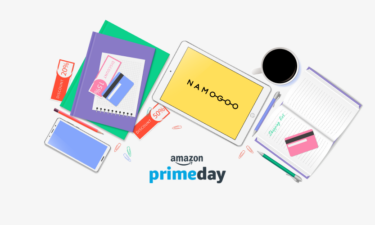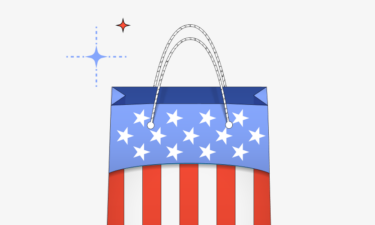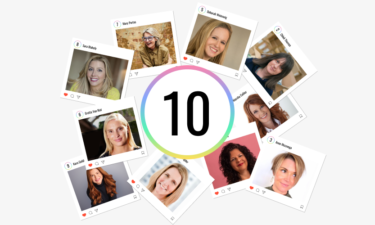Bonus material: 5 Types of Customers & What Motivates Them Guide
by Namogoo & Microsoft
In the eCommerce world, the holiday season that culminates in Christmas and New Year are the last opportunities to make it big and boost sales before the year ends. While many try to connect with shoppers with festive marketing strategies, only a few succeed.
With this guide, your brand can be one of the few who will celebrate the start of next year with a healthy bottom line and delighted customers. Keep reading to discover:
- Stats and insights into holiday shopping trends to inform your marketing strategies.
- 20+ ideas from a variety of brands including Target, BarkBox, Ashley Homestore, Dior, Walmart, Harry’s, Pottery Barn, and more.
- Actionable tips for an eventful and frictionless shopping experience that your customers will love and remember.
The 2021 Holiday Season Stats
Retail is in the midst of an all-time high shopping season—and you don’t want to miss it. National Retail Federation forecasted growth of up to 11.5% spending this year compared with the same holiday period a year ago[*]. This translates to record sales hitting between $834.4 billion and $859 billion in November and December. Of which, about 18.9% are eCommerce holiday sales—a steady increase that started from just 10.4% five years ago, as seen in the graph below[*].
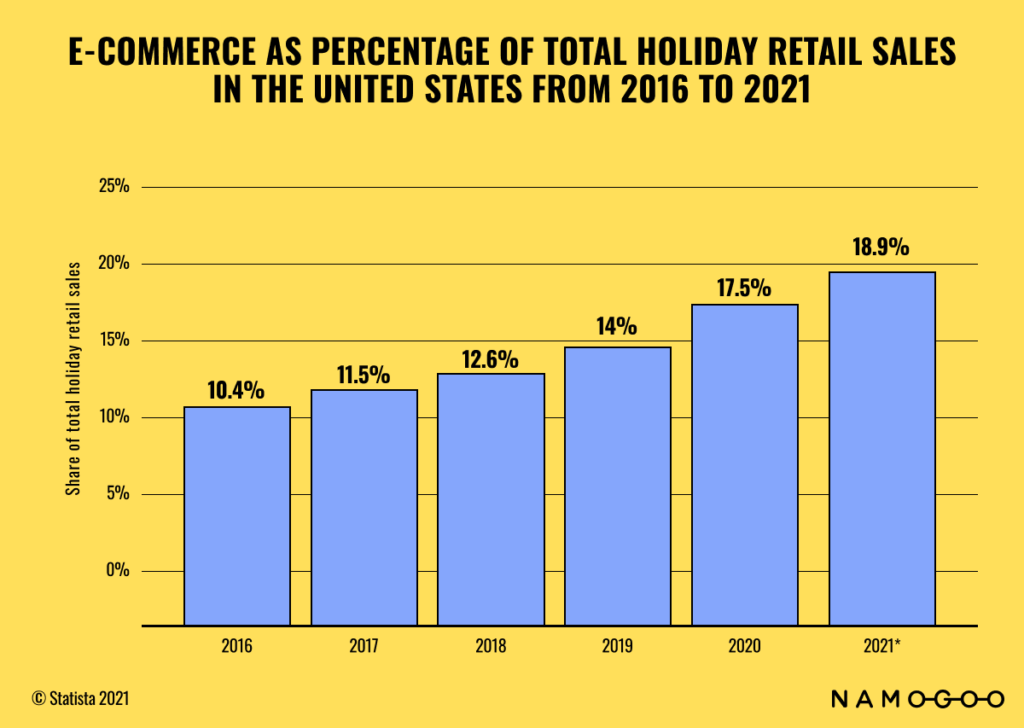
Graph and data source: eMarketer via Statista
Who’s the 2021 Holiday Shopper?
Suffice to say, the 2021 Christmas and New Year period is not only exciting for brands and retailers but also competitive. With consumers planning to spend $997.73 on holiday purchases[*], how do you ensure that your strategies capture and increase your customer’s wallet share? It’s important to know what makes your audience tick right at this moment.
Here’s what we know about this year’s holiday shoppers according to McKinsey & Co.[*]:
- 40% of consumers are expected to shop and spend earlier than they did in 2020, anticipating shortages and longer shipping times.
- 60% to 70% of consumers are shopping in an omnichannel way.
- 50% of consumers are increasing their online spending compared to last year.
- 58% of holiday shoppers consider social media as a key factor in influencing their buying behaviors.
- 40% of consumers prioritize value, 34% prioritize convenience, and 31% prioritize product availability when it comes to purchasing decisions.
As we expect the growing trend to continue this year, let’s examine the following exclusive data on conversion rates (CVR) per industry during the holiday season in 2019 and 2020. Home and Department Stores had impressive growth during the period with a 32.03% and 136.36% YoY CVR increase.
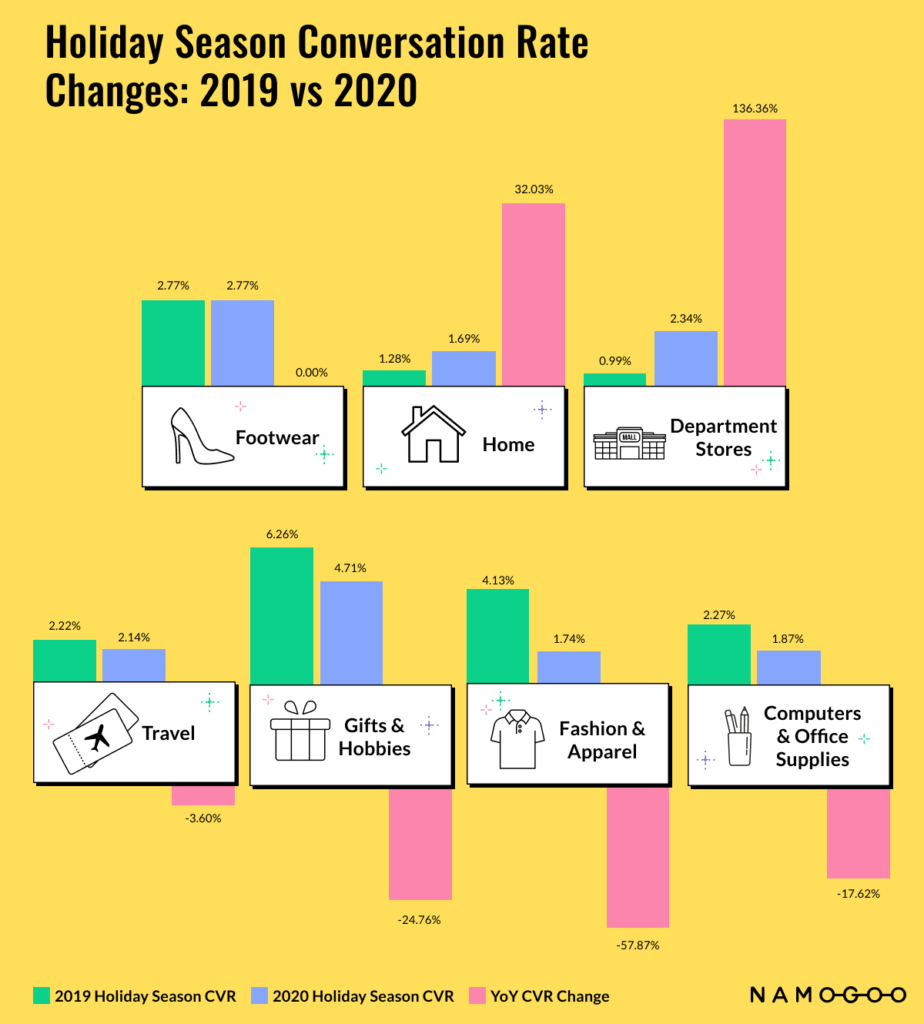
To complete the picture, let’s relate these CVRs to the findings of the McKinsey & Co. survey. It revealed that 2021 spending will reach double digits in many discretionary or non-essential categories including sporting apparel, beauty and skincare, computers and software, and retail apparel.
Top Holiday Strategies for A Memorable and Festive Shopping Experience
With so much at stake, now is the time for brands and retailers to prepare—if you haven’t already—and optimize holiday strategies. Here are 23 tips for maximizing your opportunities to delight and win customers this season.
Make Shopping Stress-free with Meaningful Content
The meaning of holiday rush depends on whom you ask. Some shoppers enjoy the thrill of hunting for the perfect gift. While others find buying Christmas presents stressful. To deliver holiday buying journeys that stick, you must be prepared to cater to all types of shoppers this season of giving.
1. Create Comprehensive Gift Guides
Online shoppers, without a doubt, have endless choices of gifts to choose from. Considering how busy the end of the year can get, looking for the right present for people who matter to them can be a daunting task. You can make gift-shopping feel like a walk in the park with a selection of gift guides that cater to different personas your customers might be shopping for.
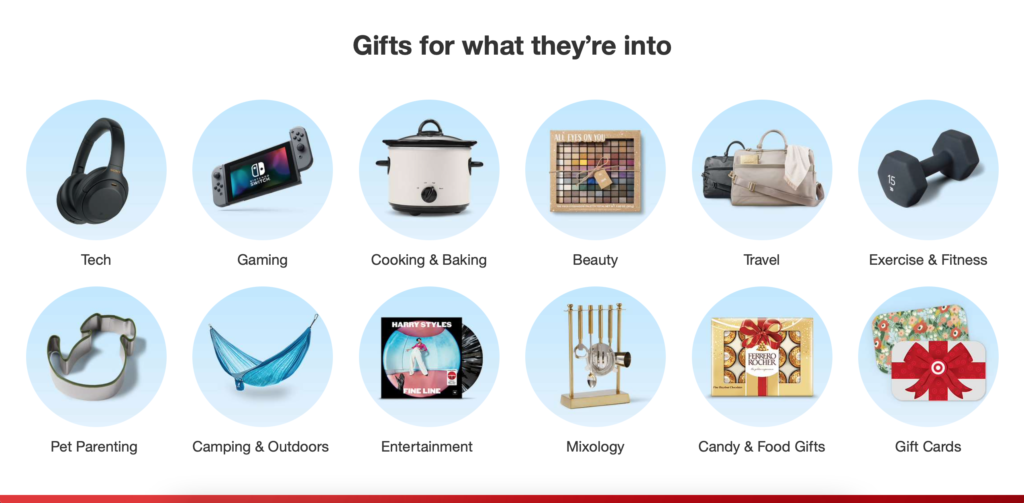
Image credit: Target
For a huge retailer like Target, gift guides are crucial to lead shoppers to products that match what they have in mind. So, the retailer crafted not just ordinary gift guides that highlight best sellers or exclusive holiday items, but also nuanced ones that depend on hobbies, recipients, and price points.
2. Speak to Shoppers’ Emotions
Emotions are heightened during Christmas and New Year. With 95% of purchasing decisions driven by emotions[*], it’s no wonder that holiday ads are almost always relatable and effective in generating a response from shoppers. With inspirational videos, persuasive copy, or user-generated content (UGC), you can set up emotion-driven campaigns that highlight the values that are important to your customers.

Image credit: Boots
Boots’ ad called “Bag of Joy” delivers just the right mix of feelings and product displays[*]. With half a million views on YouTube, it acknowledges the spirit of the season by featuring shoppers from different generations and products in the context of a story. Customers can get gift ideas as they watch the ad.
3. Make Content Shoppable
Have creative content, such as videos and images, to include in your holiday promotions? Make sure customers can find the products that you featured. This is already common on social media platforms, allowing users to seamlessly buy products right on the app. On your site, you can have a dedicated collection or page that contains promoted products for customers who are visiting from one of your ads. You can even take this a step further and engage with customers as they shop in real-time with live streaming.
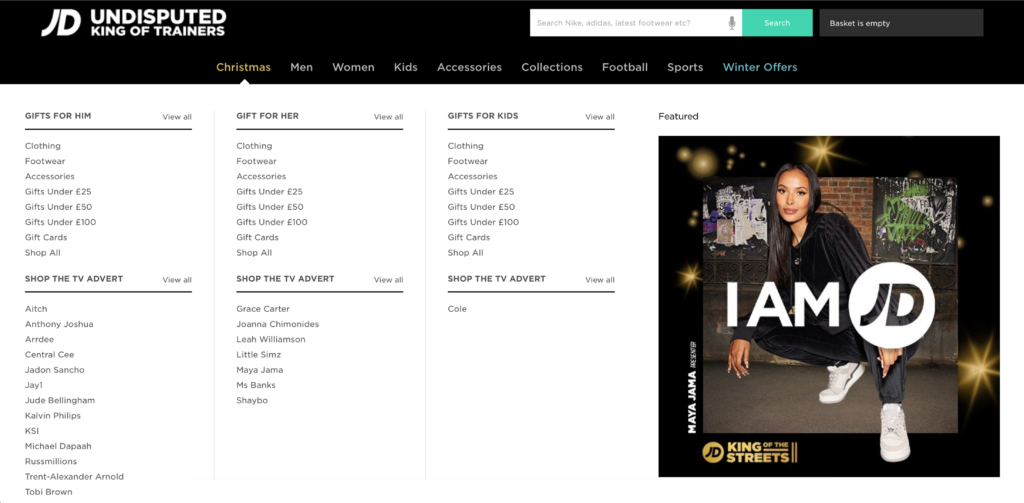
Image credit: JDSports
JDSports’ 2021 Christmas ad, “Welcome to JD Street,” is not only nostalgic being filmed at Oldham Spindles and eye-catching with all of the famous personalities, but also convenient for customers who plan to buy something[*]. On their website, JDSports has a special menu, “Shop the TV Advert,” that curates all products featured on the video ad.
4. Build Personalized Email Campaigns
Don’t forget about your email list. You don’t have to wait for customers to come to your site; you can engage them this festive season by delivering relevant content to their inbox. In addition to holiday-themed content, you can personalize your emails by highlighting items shoppers had on their wishlists with a promo code, or cherry-picked products based on their user behavior. As holiday consumers shop in an omnichannel way, this strategy can be more effective if you also send personalized SMS.
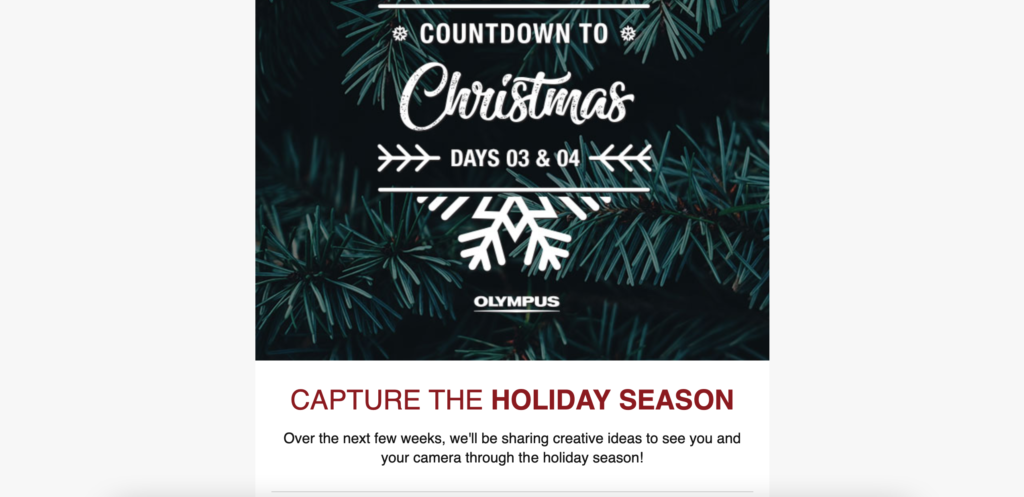
Image credit: Olympus
For Christmas, Olympus is running an educational content campaign that shares creative ideas with customers. They’re clear about the purpose and frequency of the emails. This, in turn, makes it something shoppers can look forward to.
Be Generous with Freebies and Unique Offers
Of course, holiday marketing campaigns wouldn’t be complete without promotions. Even more so as the ongoing pandemic continues to push more people, about 80% of shoppers, to actively look for deals[*]. Pandemic or not, however, who doesn’t want to score money-saving discounts? After all, multiple studies show that positive feelings come after customers snag a great deal.
5. Give Discounts Based on Intent
What are shoppers looking at on your site? Which phase of the customer journey are they in now? Naturally, brands and retailers are competing for your customers’ attention with appealing promos. So, to stand out, make sure that your offers are highly relevant by delivering promotions based on your shoppers’ intent and where they are in the customer journey.
Namogoo offers shoppers the minimum promotion needed for them to convert. Especially during the holiday shopping season, brands should take time to consider their own promotion strategy.
6. Bundle Orders to Highlight Savings
Bundling orders hit two birds with one stone. First, customers can get more items at a discounted price. Second, you’re providing them with a compelling reason, or in this case, offer, to complete a purchase with more products.
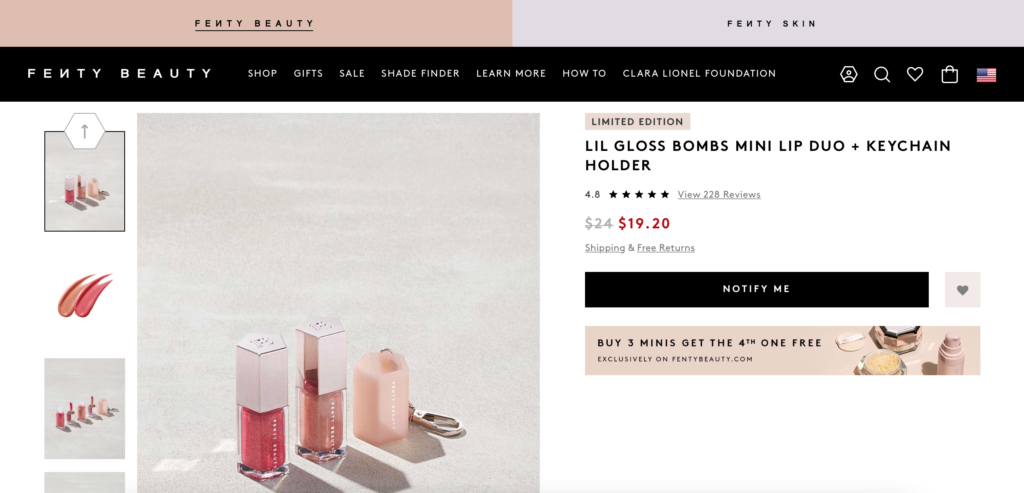
Image credit: Fenty Beauty
Fenty Beauty, for example, gives one product for free when shoppers buy three. For customers who are looking to maximize their money, this is a great deal. They can gift the items separately, use one as a stocking stuffer, or keep it all to themselves as a sample set or travel-size product companions.
7. Experiment with Unique Offers Placement
Have you ever seen the same ads or banners so many types that you just ignore them? Banner blindness is a thing that brands need to constantly consider when planning new marketing campaigns. To prevent this from happening, you can experiment with a new creative layout, a different way of delivering promo codes to shoppers, or a unique location for offers on your site.
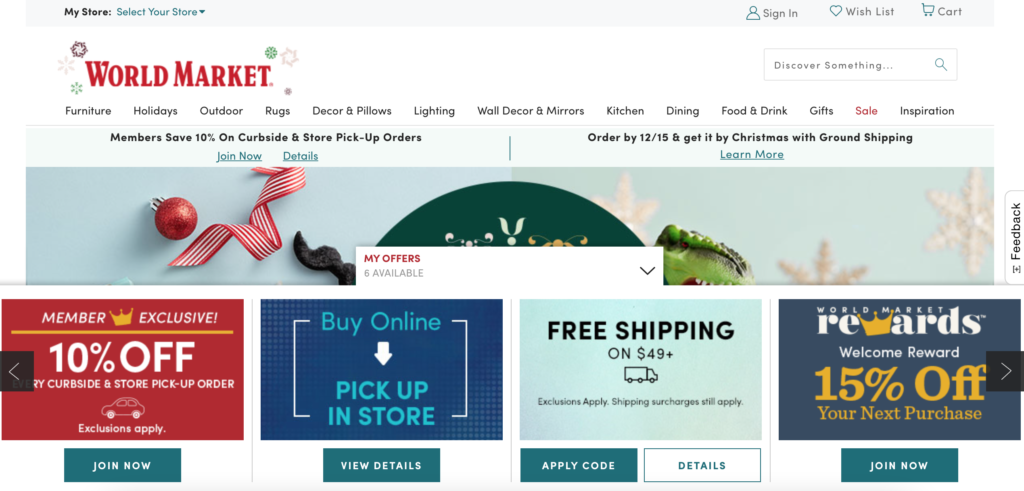
Image credit: World Market
World Market revamped their homepage for the holidays. Instead of distracting users with multiple in-line banners, they hid all promotions in a sticky popup menu that shoppers can open at their own pace. Moreover, the discount menu is labeled “My Offers” which gives it a more personal feel.
Prevent Shopping Cart Abandonment
One of the most frustrating things and essentially a low-hanging fruit for many brands is shopping cart abandonment. About 69% of online shoppers leave their carts just a few steps away from completing a purchase. While many reasons might be out of your control, there are several ways for you to try to turn your shoppers’ high intent to purchase into sales.
8. Be Transparent About Shipping Cost
It’s a common scenario. Customers are shopping to their hearts’ content and when the time comes to pay—and this is after they sign up and input their shipment details—they’re completely shocked by the amount of shipping fee. So, they abandon the shopping cart. Don’t let this happen to your brand. Always keep shoppers in the loop about the total amount they’re going to pay for in the end.
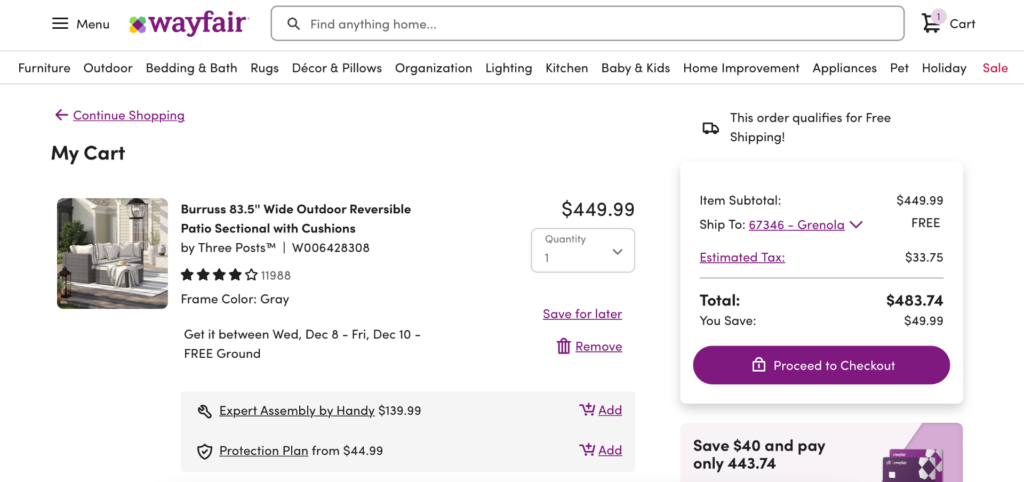
Image credit: Wayfair
Wayfair is clear about where the product is headed and how much the shipping cost is. This removes uncertainty and boosts shoppers’ confidence in their chosen products.
9. Add More Ways to Checkout
Keeping the checkout process as clean and simple as possible is one of the surest ways to prevent shopping cart abandonment. In addition to allowing guest checkout, you can also present multiple options for customers to get their hands on your products.
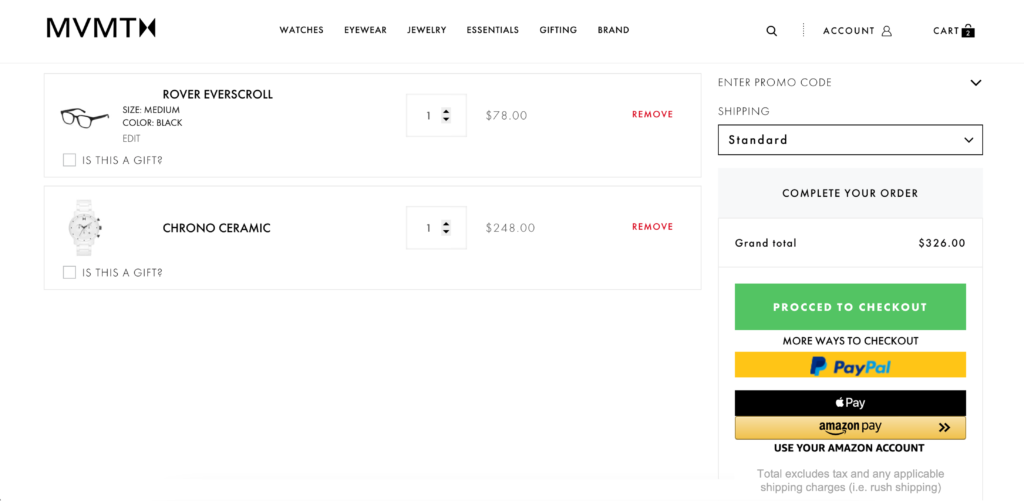
Image credit: MVMT
MVMT allows shoppers to add a promo code and choose the type of shipping that they’re comfortable with. Moreover, the brand also has several payment options that provide customers not only with choice but also convenience.
10. Include an Exit Popup
An exit popup is a common, and often the final opportunity, to encourage shoppers to stay on your site and buy. Besides the usual discount, you can get creative by communicating the actual value that customers will get at that exact moment should they choose to go back and complete the purchase.
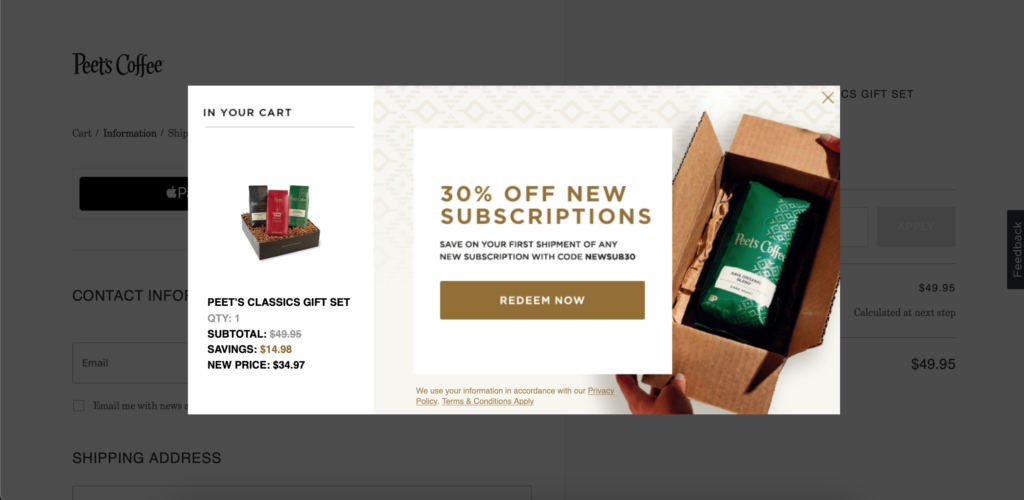
Image credit: Peet’s Coffee
Peet’s Coffee’s exit popup is no ordinary exit popup. In addition to the huge discount for new customers, they include a snapshot of the users’ shopping cart. Applying context in the promotion, Peet’s Coffee illustrates the savings and final amount that shoppers could get.
Increase Average Order Value
Holiday shopping is often a planned activity. Customers do set aside budgets just for this time of the year. You can increase your share of the market by inspiring impulsive purchases that are founded on adding more value to shoppers.
11. Offer to Buy and Claim Gift Card
Gift cards are straightforward, easy, and less wasteful than gifting something that recipients wouldn’t end up using. Moreover, a study found that consumers spend more than the gift card value which is great news for brands[*]. Make sure you offer this option to your shoppers. You can place it on the menu for quick access. Shopping cart is also a strategic location for last-minute purchase decisions.
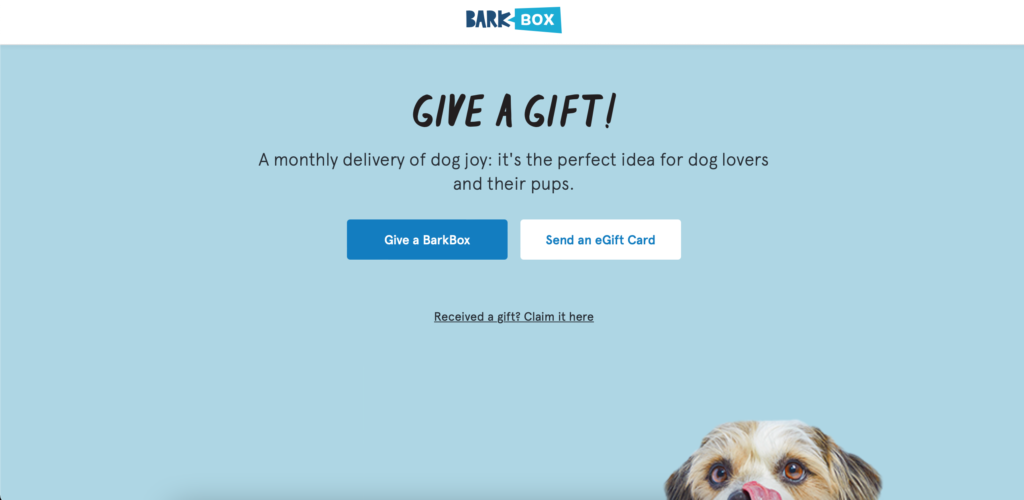
Image credit: BarkBox
On BarkBox’s homepage, the hero image features gift cards that shoppers can buy or claim. When shoppers start the buying process, the brand welcomes them with a form to ensure that the gift card is personalized according to the receiver’s details.
12. Recommend Complementary Products
Users will show interest in products related to the items they’re viewing as long as there’s relevance and added value. For instance, checking out pillows can have shoppers also looking at pillowcases, beddings, and bedroom furniture.
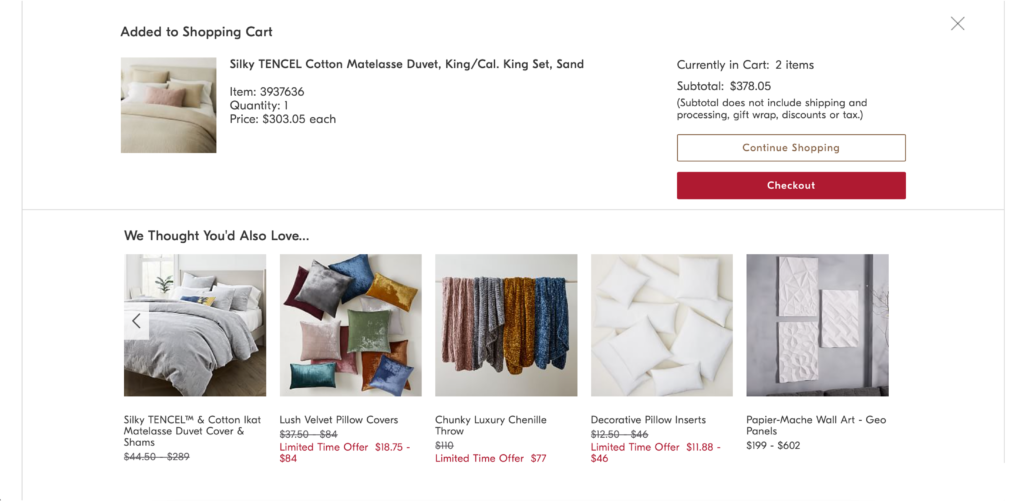
Image credit: West Elm
Like West Elm, you can boost last-minute add to cart items by having a recommendation carousel on your shopping cart. Product suggestions, like offers, are more effective if they are based on current intent. So, it’s crucial to understand and act according to your customers’ current context.
13. Set an Accessible Shipping Threshold
The holidays could be the only time when expedited shipping is common particularly for gift shopping procrastinators, but it’s no surprise that 82% of shoppers prefer free shipping to paying extra for faster shipping[*]. You can offer the same by allowing shoppers to purchase items with a certain total amount to pay no shipping charges.
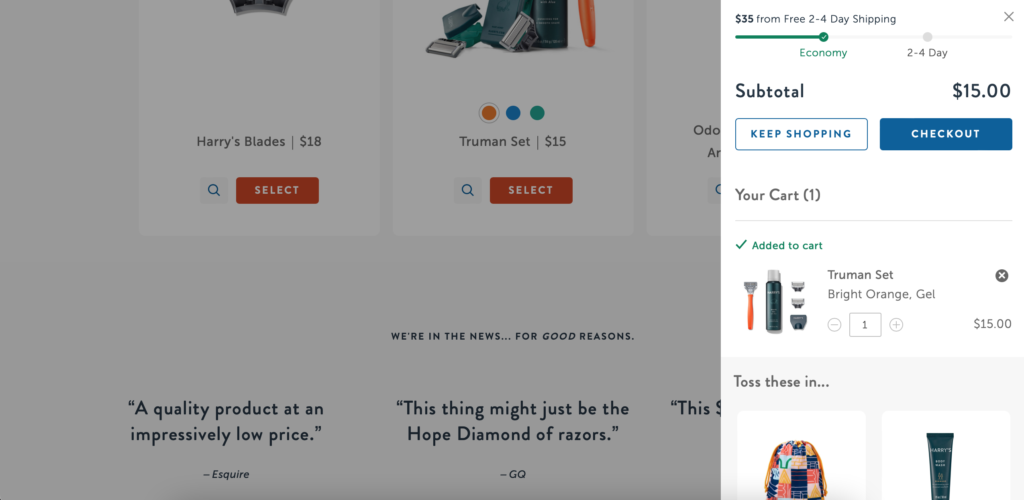
Image credit: Harry’s
Harry’s takes it a step further. The brand offers a tiered shipping arrangement that can combine free and faster shipping. They make it clear on the shopping cart that customers can get expedited shipping without an extra charge once they reach a minimum amount.
Create Excitement and Urgency
Limited deals are not only for Black Friday and Cyber Monday. You can replicate the same sense of urgency by focusing your effort on the right types of customers. Who would be most attracted and excited to avail exclusive and time-based discounts? Think of bargain hunters, last-minute shoppers, and customers on a budget.
14. Set Up Countdowns for On-Sale Items
Having time-sensitive promotions on-site can boost conversions. To make this Christmas and New Year strategy successful, you must ensure that the discounted items up for grabs are relevant to the season.
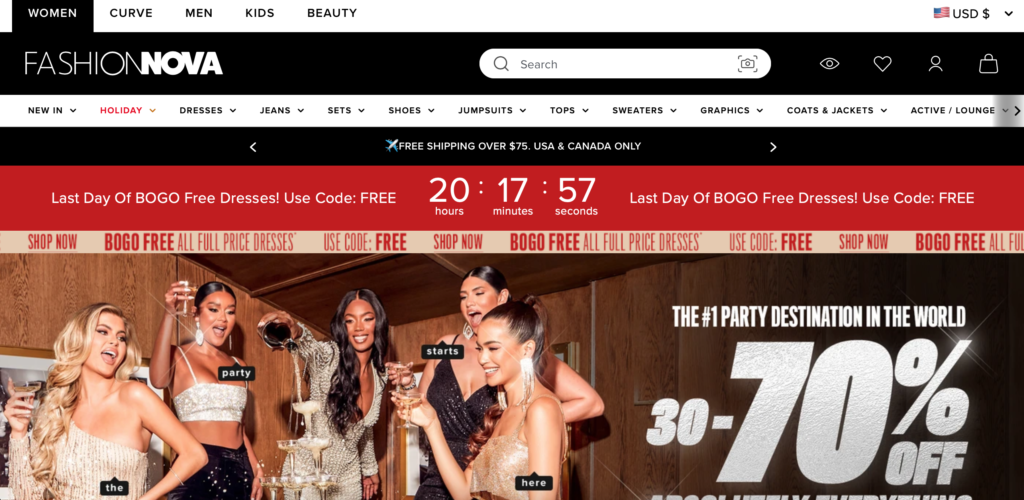
Image credit: Fashion Nova
For instance, Fashion Nova’s sale countdown for dresses are timely and relevant. Parties? Family gatherings? Reunions? Shoppers are on the hunt for the perfect dress to wear to these festive occasions.
15. Release Limited/Holiday Exclusive Products
Another popular holiday marketing strategy is to launch exclusive products. You can use this tactic to re-engage existing customers, spur conversions within your community of loyal shoppers, or simply boost engagement and visits on your site.
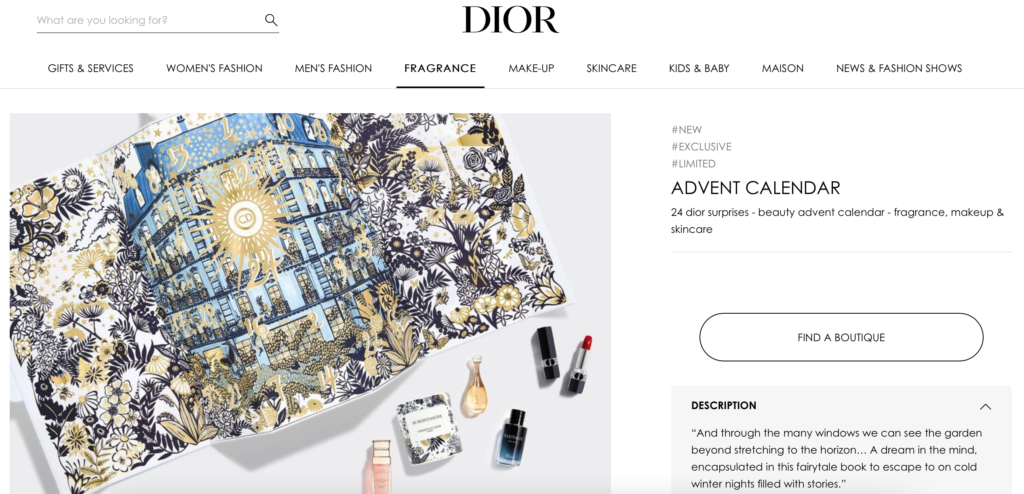
Image credit: Dior
Dior recently released an advent calendar that combines their beauty, fragrance, and skincare products. For fans of Dior, this is a no-brainer purchase. At the same time, the sample size items can also encourage new customers to try out several of the luxury brand’s products in one purchase.
16. Communicate Order and Shipping Deadlines
Managing logistics during the holiday rush is a challenge for both brands and customers. With a reminder about your shipping schedule, you not only prompt shoppers to complete their purchases on time, but also ensure a positive customer experience by managing their expectations.
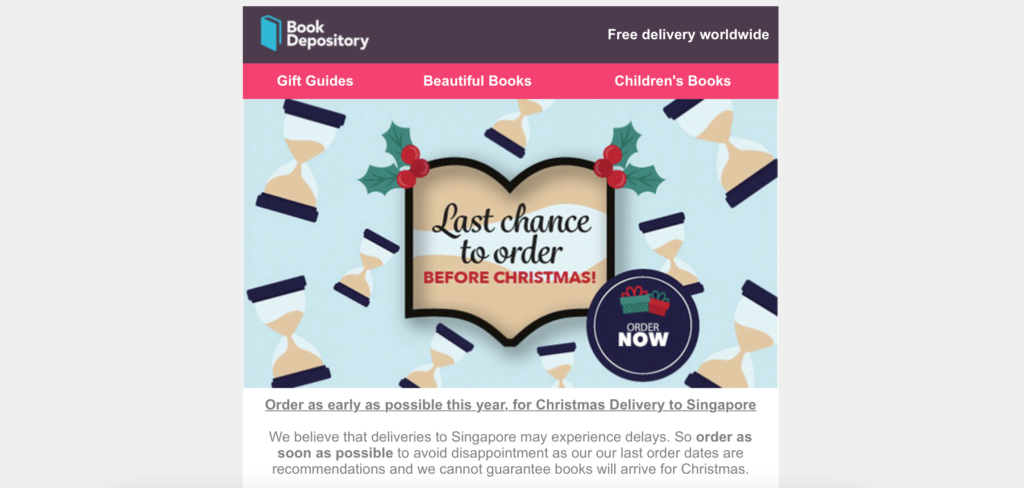
Image credit: Book Depository
Book Depository sends a customized email according to customers’ location. It encourages them to order as soon as possible to prevent delays and receive the items before Christmas.
Be Active on Social and Community
Finally, a list of holiday marketing strategies wouldn’t be complete without a section on ramping up social and community engagement. Social media platforms—where you’ll find many of your customers—are critical touchpoints that shouldn’t be missed during the season of gifting.
17. Feature UGC as Social Proof
As shoppers research your products, reviews, recommendations, or feedback from fellow customers are essential sources of trust and confidence. By featuring UGC on your site, you can make your brand more accessible and relatable to new and current customers. You can put it on site pages that will help shoppers in their decision-making process or product discovery phase such as product detail pages and the homepage.
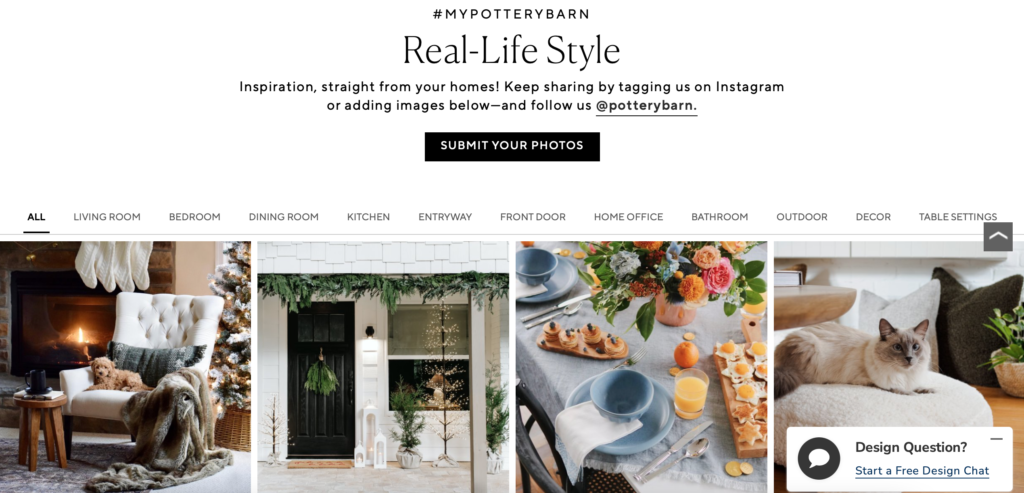
Image credit: Pottery Barn
Pottery Barn has a dedicated landing page for UGC. Site browsers can explore these images for inspiration. On social, the brand benefits from organic engagement as customers mention or tag their account. You can inspire genuine conversions with shoppers by doing something similar.
18. Create Contests to Boost Organic Engagement
Another way to boost conversations and create buzz on social media is by creating contests. You can implement it in a way that requires participants to post UGC, tag their friends and family, and/or comment on your posts.
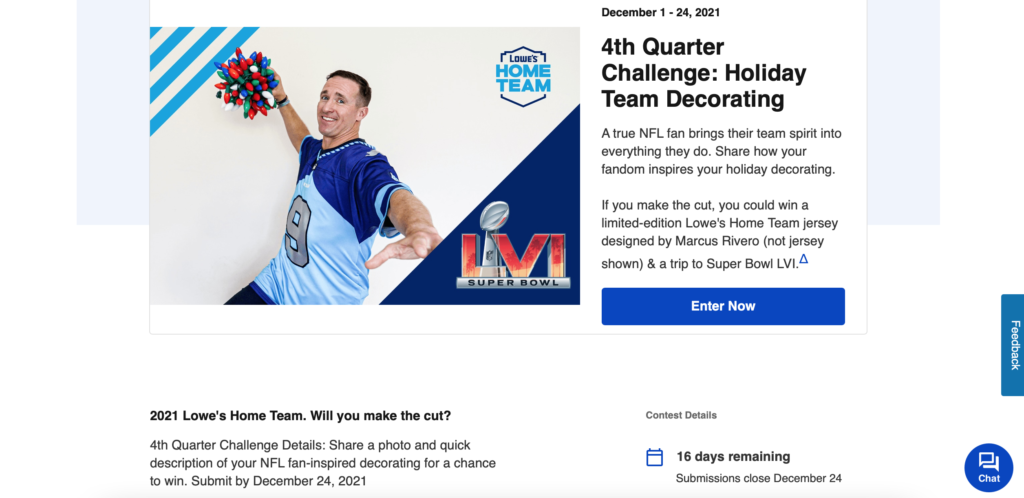
Image credit: Lowe’s
Lowe’s has year-long contests that change based on the celebrations of the time. For Christmas and New Year, the brand combines popular sports personalities with a social media-focused contest for maximum impact.
19. Collaborate with Content Creators and Influencers
Planning to extend your reach to more audiences or new markets? Partnering up with influencers could be a good idea. The key here is to choose content creators wisely. Depending on your brand values, you can collaborate with those who are truly engaged and connected with their community.
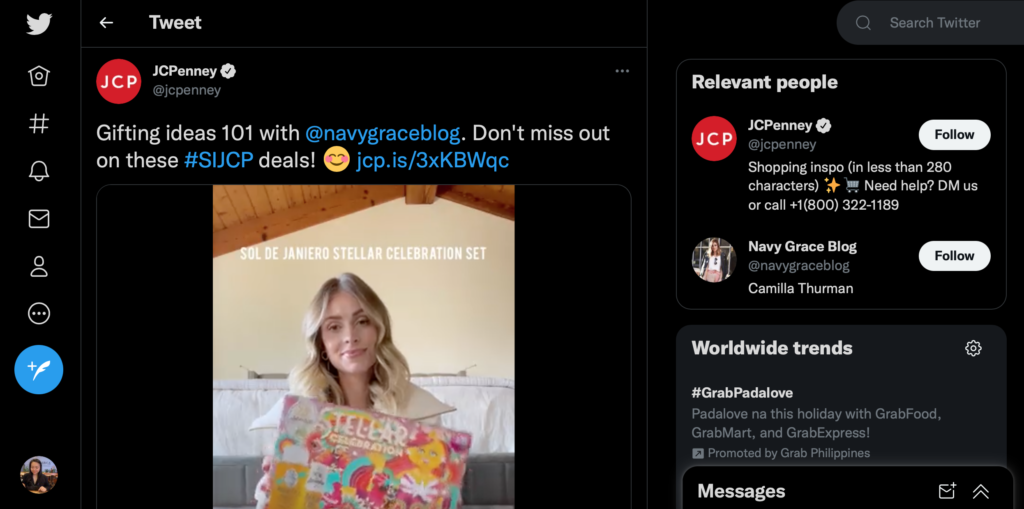
Image credit: JCPenney
JCPenney partnered with Camilla Thurman of the Navy Grace Blog to promote the retailer’s holiday products. Through a short video, viewers can have an idea of the products that JCPenney carries or get inspiration for gifts to buy.
Bonus: Get Inspired by These 4 Christmas and New Year’s Marketing Campaigns
Let’s learn from more holiday marketing strategies, shall we? The following are extended examples of thematic campaigns from big retailers that we first introduced through Target and JD Sports. They’re also some of the most popular eCommerce websites for the holiday season among shoppers in 2020 and 2021 such as Amazon, Levi’s, and Walmart[*].
1. Amazon’s “Kindness, the greatest gift”[*]
The 2021 holiday theme of Amazon centers on kindness. In addition to the video, the marketplace ensures that the site is ready to spread kindness through gift-giving. They promote a gift registry especially for the holiday season that customers can use. It’s free and easily shareable.
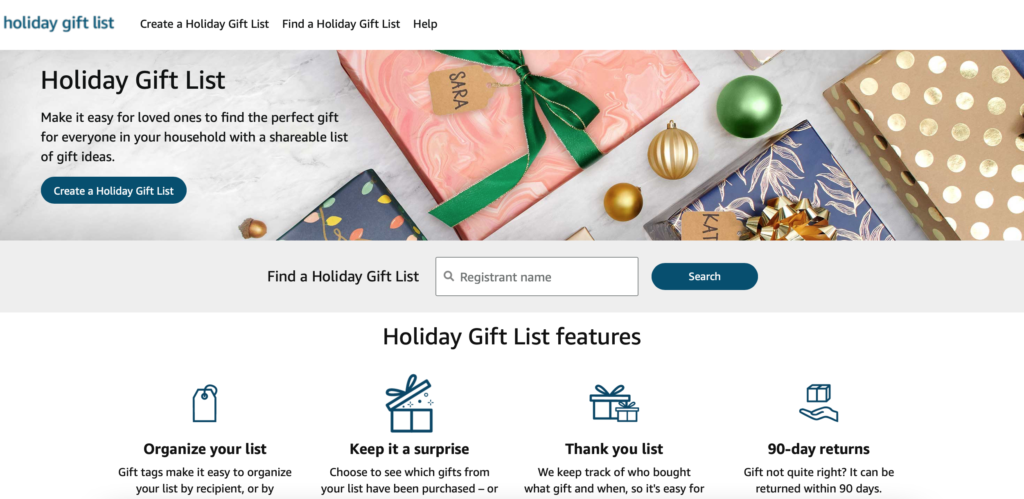
Image credit: Amazon
2. Walmart’s “Family Portrait: A Joy-filled Christmas Card from Walmart”[*]
Walmart’s video ad is heartfelt and relatable. It features families from different backgrounds and promotes harmony—the spirit of Christmas. To continue the experience from the ad to their website, Walmart has a section for customized greetings that shoppers can purchase[*].
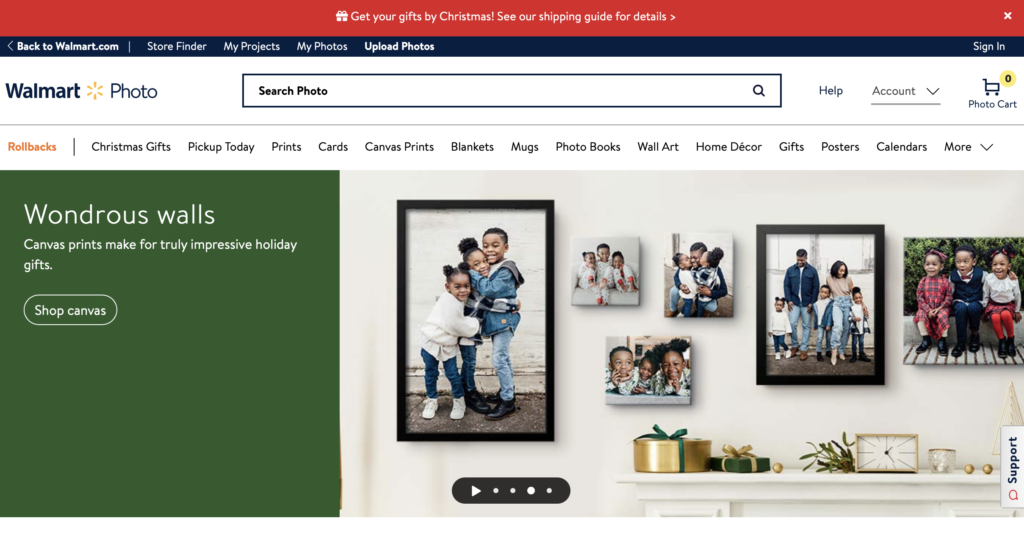
Image credit: Walmart
3. Levi’s “Give Better”[*]
More consumers are realizing the negative impact of fast fashion. As a result, brands are slowly making changes to adopt more sustainable practices. This is what Levi’s highlights in their 2021 Christmas and New Year campaign. On their site, the brand promotes clothing and gifting tips that champion sustainability. Levi’s is also educating shoppers about the concept while sharing information about what they’re doing to contribute to the cause.
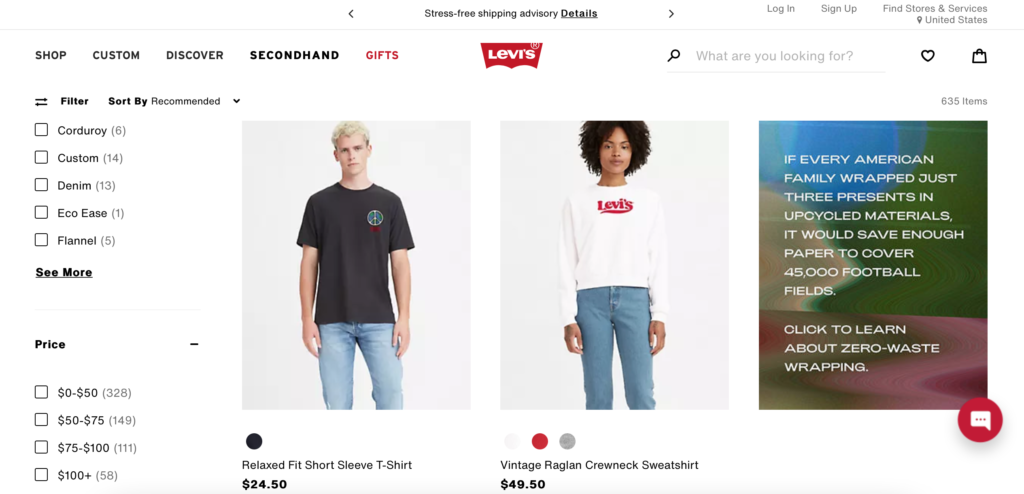
Image credit: Levi’s
4. Ashley Homestore’s “Magic of Home”
Home makeovers are timeless content that shoppers can easily relate to. Ashley Homestore hit a jackpot by combining a series on home renovation with sweepstakes that customers wouldn’t second guess joining in. Plus, they’re repurposing the videos and turning them into mini-episodes posted on social media.
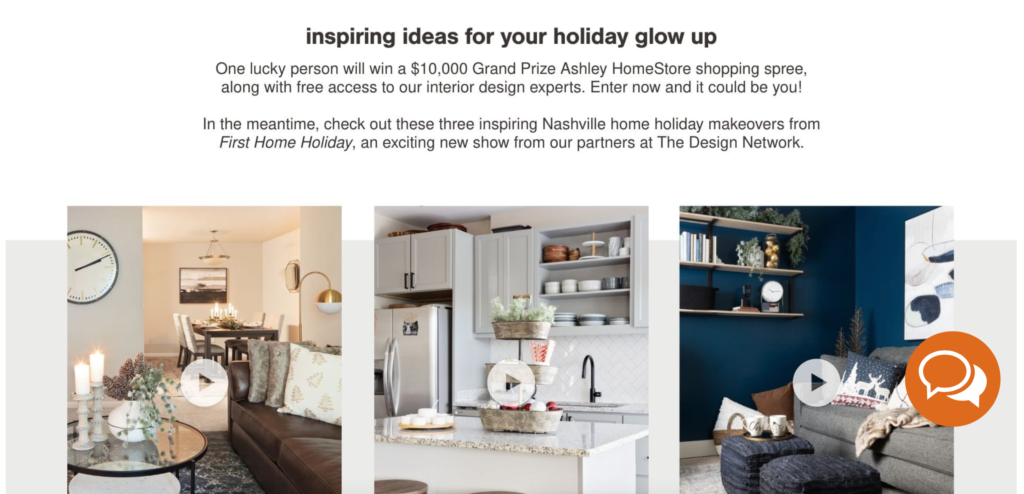
Image credit: Ashley Homestore
Are You Ready to Deliver Shopping Moments Filled with Relevance and Cheer?
At least 19% of annual retail sales happen during the holiday season[*]. For some brands, it’s even higher. So, how could you increase the percentage of your holiday sales this year?
First, you can implement any of the marketing strategies presented above. Second, and this is equally important, is to have an overall approach that focuses on helping shoppers to beat the holiday rush and shop stress-free. This means personalizing the customer journey from the unique offers that you deliver to the small tweaks that remove barriers to a festive shopping experience.
It’s not too late to craft holiday experiences worth coming back for. Act now and you’ll reap the benefits of delivering seamless and customer-first shopping journeys as you ring in 2022.




